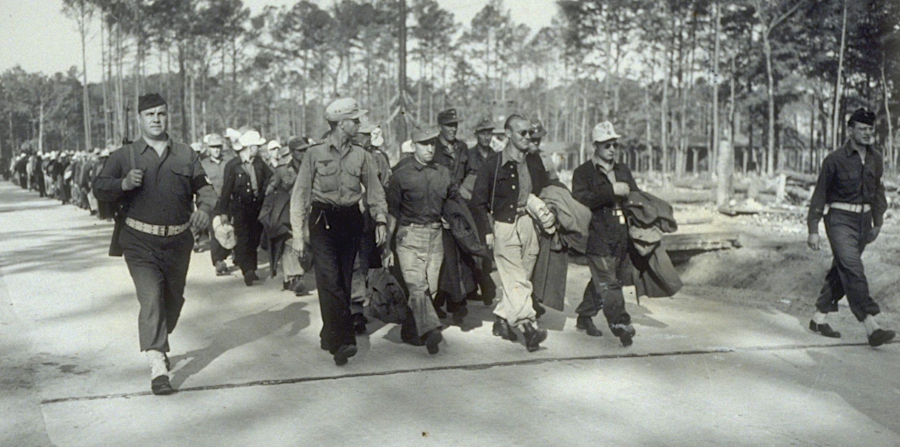
German prisoners of war arriving to work at Camp Patrick Henry, Virginia, 5 May 1944
Source: UnCommonwealth blog, Library of Virginia, Prisoners Of America (March 20, 2023)

German prisoners of war arriving to work at Camp Patrick Henry, Virginia, 5 May 1944
Source: UnCommonwealth blog, Library of Virginia, Prisoners Of America (March 20, 2023)
The office of provost marshal general in the US Army has managed prisoners since the American Revolution. The office was re-established during the Civil War, Spanish-American War, and World War I. It was reactivated in 1941 and lasted until 1974. The office was renewed again after the 9/11 terrorist attacks, and remains in operation today.1
By the end of 1942, there were only 1,881 enemy prisoners held in the United States. Federal agencies established policies for their treatment, including acknowledging that enemy prisoners should be treated under the Convention Relative to the Treatment of Prisoners of War. That "Geneva Convention" had been adopted in 1929 after World War I, and the United States desired that American prisoners also be treated according to its terms.
By May 1943, after the North Africa Campaign, ships had brought 240,000 German and Italian prisoners of war to the United States. They were sent across the Atlantic Ocean in order to allow front-line forces to focus on fighting rather than guarding prisoners. Prisoners captured by the United Kingdom were also sent to America for the same reason.
Initially prisoners were sent to Civilian Conservation Corps (CCC) camps at least 170 miles inland from the coastline. Later, spare space at military bases was used and special facilities were constructed to house the prisoners. By the end of the war in Europe in 1945, 426,000 prisoners were kept in 490 camps of various sizes.2
The first camp to be established in Virginia was at Fort Hunt. The Department of the Interior turned over the site to the War Department on May 15, 1942. It became the East Coas military intelligence center, used to interrogate high-value German and Japanese prisoners.
The prisoner of war base camps constructed in Virginia resembled the miliary training camps. Wooden barracks for 50 men were spartan. Roofs were covered with tar paper or corrugated iron, floors were a concrete slab. Inside each of the barracks were rows of wooden bed frames with wire mesh springs, footlockers for storing clothing and personal items, and a pot-bellied stove for heating. Typical base camps had 2,000-4,000 prisoners, with interior fences separating 1,000-prisoner compounds.
Branch camps were smaller, holding 250-750 prisoners. Branch camps were set up in local facilities (including auditoriums, prisons, and hospitals) or open areas such as fairgrounds with tents for housing. Branch camps were established near farms and factories where prisoners were sent to work.3
Source: Albemarle Charlottesville Historical Society, Virginia POW Camps in WWII
During World War II, German and Italian prisoners were brought to the United States through Hampton Roads ports. About 17,000 were kept in Virginia at 41 prisoner of war facilities, 23 camps where farmers and businesses could rent prisoner labor temporarily, plus an intelligence debriefing site at Fort Hunt near Washington, DC.4
The first prisoners of war brought to Virginia had been captured during the North Africa Campaign. At Fort Eustis, efforts to de-Nazify prisoners included teaching a six-day course in democracy. 5
German prisoners were also incarcerated at Coffee Pot Bottom along Stroubles Creek near Radford. Some were tasked with maintaining the grounds at the Radford Ordinance Work (now the Radford Army Ammunition Plant). A camp for 1,500 prisoners was constructed at Richmond General Depot (now Defense Supply Center Richmond). Between 1943-1945, there were 1,200 Germans kept there.6
Source: Access Virginia Beach, Camp Ashby Highway Marker Dedication